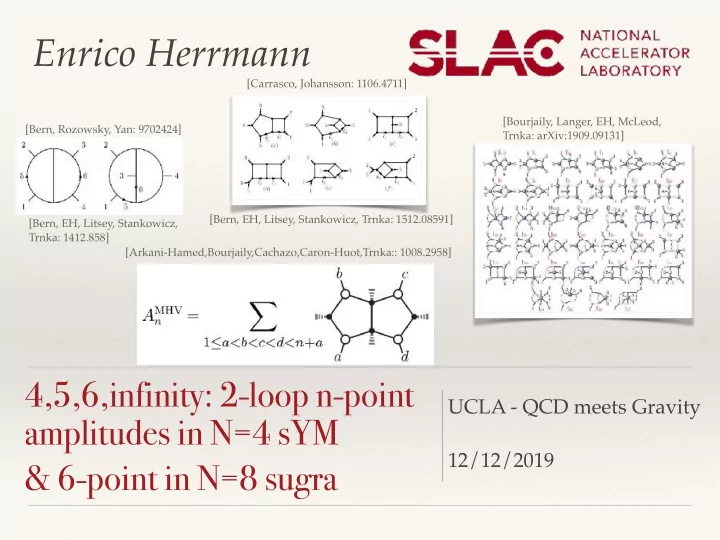

Enrico Herrmann [Carrasco, Johansson: 1106.4711] [Bourjaily, Langer, EH, McLeod, [Bern, Rozowsky, Yan: 9702424] Trnka: arXiv:1909.09131] [Bern, EH, Litsey, Stankowicz, Trnka: 1512.08591] [Bern, EH, Litsey, Stankowicz, Trnka: 1412.858] [Arkani-Hamed,Bourjaily,Cachazo,Caron-Huot,Trnka:: 1008.2958] 4,5,6,infinity: 2-loop n-point UCLA - QCD meets Gravity amplitudes in N=4 sYM 12/12/2019 & 6-point in N=8 sugra
Motivation Déjà vu? Jake Bourjaily commented on a proposed n-point formula in N=4 sYM @ 2017 QCD meets GR
Background What is a scattering amplitude? tree-diagram loop-diagram ? Feynman diagrams - Richard P. Feynman 1950’s
Background Feynman diagrams are NOT the end. slide: Zvi Bern Tree-level gluon scattering gg → ggg 2 3 4 + ⋯ 5 1 + many more pages of mess ⟨ 12 ⟩ 4 ⟨ 12 ⟩⟨ 23 ⟩⟨ 34 ⟩⟨ 45 ⟩⟨ 51 ⟩ Incredible simplicity of final result! How? Parke/Taylor (1985)
The unitarity method ✦ idea: work only with physical quantities spacetime locality: scattering amplitudes factorize into simpler amplitudes BCFW recursion relations [Britto, Cachazo, Feng, Witten: arXiv:0501052] unitarity method [Bern,Dixon,Kosower: 9708239,0404293] [Britto,Cachazo,Feng: 0412103] cut cut on-shell functions: product of tree-level amplitudes [Cutkosky 1960] “gauge-invariant” building blocks: export simplicity to loops
The unitarity method ✦ practically: - write down an ansatz of local integrands - compare their cuts to those of field theory ✦ example: - 1-loop 4-point in N=4 sYM { } ↔ 4 = ∑ (1) c i ℐ i 2 3 c = ∫ [ d 4 ℓ ] s 12 s 14 ℐ box = b d i a 2 b 2 c 2 d 2 a 1 4 theory-specific information 2 3 c [color, helicity,…] = ∫ [ d 4 ℓ ] [ [1, a , c ,3] ] ℐ χ − box = b d kinematic integrand N ( ℓ ) a 2 b 2 c 2 d 2 a basis elements 1 4
Integrand basis of rational functions ✦ practically: - write down an ansatz of local integrands ✦ ansatz: - complete basis of rational functions - precise def. is a bit involved, depends on D & powercounting of the theory & L - work in D=4 and triangle powercounting [Bourjaily, EH, Trnka: to appear]
Matching unitarity cuts = linear algebra ✦ name of the game: - fix integrand coefficients c i n = ∑ ( L ) c i ℐ i i ✦ Is there a preferred basis of integrands ? ℐ i 1) maximal cuts (back to 1-loop 4-pt example): a 2 = b 2 = c 2 = d 2 =0 [ ∑ c i ℐ i ] = c box Res = i { normalize integrands to unity: {±1,0} 4 = ∑ gauge-invariant c box = ∏ A 3, j coefficients, on-shell function states j =1
Matching unitarity cuts = linear algebra ✦ name of the game: - fix integrand coefficients c i n = ∑ ( L ) c i ℐ i i 2) next-to-maximal cuts: d 2 = 0 [ [ Res = = c box + c tri + c ′ � a 2 = c 2 = 0 box = ∑ A 4 × A 3 × A 3 states known { = f ( z ) solve for c[tri] — linear algebra problem
Prescriptive unitarity: ‘no’ linear algebra 2) next-to-maximal cuts: d 2 = 0 [ [ Res = = c box + c box + c tri a 2 = c 2 = 0 = ∑ A 4 × A 3 × A 3 = f ( z ) states redefine integrands so they become diagonal on spanning set of points = 1 pick arbitrary point z * : = 0 = 0 z = z * z = z * z = z * coefficient c tri is single os-function: c tri = z = z * integrand basis is diagonalized in cuts
Properties of prescriptive representations ↔ ✦ diagonalization in cuts: 1 basis integrand 1 on-shell fct. ↔ ↔ ↔ ✦ extreme efficiency in amplitude construction [Bourjaily, EH, Trnka: arXiv:1704.05460] [Carrasco, Johansson: 1106.4711] [Bern, Rozowsky, Yan: 9702424] [Bern, EH, Litsey, Stankowicz, Trnka: 1412.858] [Bern, EH, Litsey, Stankowicz, Trnka: 1512.08591] [Bourjaily, Langer, EH, McLeod, [Bourjaily, Langer, EH, McLeod, Trnka: 1911.09106] Trnka: 1911.09106]
2-loop 6-pt amps in N=4 sYM and N=8 sugra ✦ arbitrary points can introduce spurious singularities z * ✦ for nice amplitudes, one should not pick arbitrary points z * [Bourjaily, Langer, EH, McLeod, Trnka: arXiv:1909.09131] ✦ 2-loop 6-pt MHV in N=4 sYM & N=8 sugra ✦ individual poles at infinity ✦ defining points: - soft-collinear cuts, - absent poles at infinity = ∑ (2), 𝒪 c 𝒪 ℐ i i 6 i match sYM and sugra simultaneously
2-loop n-point MHV amplitudes in N=4 sYM ✦ alternate (superior) representation: [Bourjaily, Langer, EH, McLeod, Trnka: 1911.09106] ✦ integrand is surprisingly simple, e.g. extremely small number of building blocks required
2-loop n-point MHV amplitudes in N=4 sYM ✦ all `boundary’ leg ranges smoothly degenerate: ✦ on-shell functions have the same property : degenerations expose IR-structure of theory
Conclusions ✦ saw extreme efficiency of integrand construction ✦ prescriptive unitarity avoids large systems of linear algebra ✦ clean representations of amplitudes, requires care ✦ constructed 2-loop 6-point integrands for both N=4 sYM and N=8 sugra simultaneously ✦ our integrands, have nice dog properties, candidate master integrals for canonical differential equations! ✦ 2-loop n-point integrands for N=4 sYM with many desirable features ✦ open question: how to extend this technology to d-dimensions
THANK YOU FOR THIS STIMULATING WORKSHOP!
Recommend
More recommend